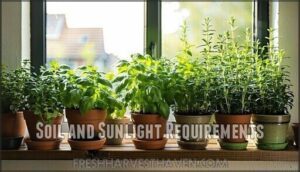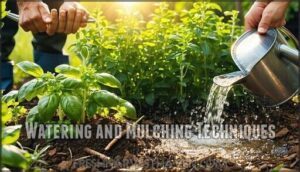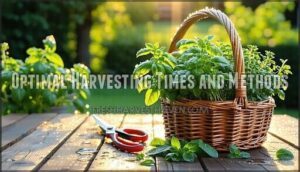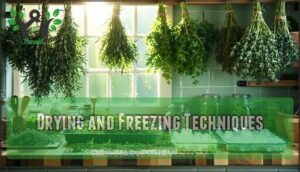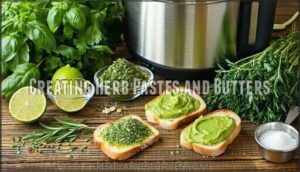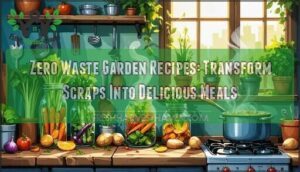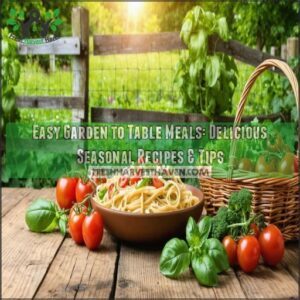This site is supported by our readers. We may earn a commission, at no cost to you, if you purchase through links.
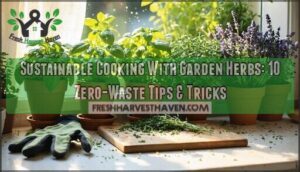
You’ll slash grocery costs while eliminating plastic packaging waste from store-bought herbs.
Fresh basil provides 145% daily vitamin K, while parsley delivers exceptional iron and vitamins A and C.
Your herb garden attracts beneficial pollinators, reduces transportation emissions, and creates a personal pharmacy of natural remedies.
Chamomile calms nerves, peppermint soothes digestion, and lavender reduces stress through aromatherapy.
A single $3 basil plant replaces $80 in annual purchases.
Choose climate-appropriate varieties, make certain well-drained soil, and provide six hours of daily sunlight.
The secrets to maximizing your harvest and creating zero-waste preservation methods reveal even greater kitchen potential.
Table Of Contents
- Key Takeaways
- Herb Garden Benefits
- Growing Herbs Sustainably
- Harvesting and Preserving Herbs
- Cooking With Fresh Herbs
- Sustainable Kitchen Practices
- Frequently Asked Questions (FAQs)
- Is growing your own herbs sustainable?
- What to make with herbs from the garden?
- What is the mother of all herbs?
- How to cook with fresh herbs?
- How do you sustainably harvest herbs?
- How do you keep herbs green when cooking?
- Can I use herbs straight from the garden?
- What is the most versatile herb for cooking?
- Can herbs grow indoors without sunlight?
- How often should herb seeds be watered?
- Conclusion
Key Takeaways
- You’ll slash grocery costs dramatically – A single $3 basil plant replaces $80 in annual store purchases, while growing your own herbs cuts weekly expenses by up to $150 compared to buying packaged varieties.
- Your garden becomes a natural pharmacy – Fresh herbs like chamomile calm nerves, peppermint soothes digestion, and lavender reduces stress, giving you medicinal remedies right outside your kitchen door.
- You’ll eliminate food waste completely – Harvesting exactly what you need prevents spoilage, while preservation methods like freezing herb cubes and making infused oils extend your harvest year-round.
- Your environmental impact drops significantly – Growing herbs cuts your carbon footprint by 1.8 kg CO2e weekly, eliminates plastic packaging waste, and attracts beneficial pollinators to support local ecosystems.
Herb Garden Benefits
Growing your own herbs transforms your kitchen into a nutrient powerhouse while dramatically reducing your environmental footprint.
You’ll harvest herbs packed with three times more antioxidants than store-bought varieties, save up to $150 annually, and cut your weekly carbon emissions by 1.8 kg CO2e, which can lead to a significant environmental impact.
Nutritional Value of Herbs
Your garden herbs are nutritional powerhouses delivering impressive Vitamin Content and Mineral Richness. Fresh basil provides 145% daily vitamin K, while parsley offers exceptional Nutrient Density with vitamins A, C, and iron.
Turn kitchen scraps into garden gold—herb stems become tomorrow’s harvest
These vitamin rich foods contain Herbal Antioxidants that combat inflammation and support immune function. Herbs and spices have anti inflammatory properties that can enhance overall wellness.
- Vitamin K strengthens bones and aids blood clotting
- Antioxidant power fights cellular damage naturally
- Essential minerals support heart and muscle function
- Phytochemical Benefits boost overall wellness substantially
Medicinal Properties of Herbs
Beyond their nutritional value, your garden herbs become powerful allies in natural remedies and herbal medicine.
Chamomile calms nerves naturally, while peppermint soothes digestive troubles with remarkable efficiency.
Lavender’s botanical cures reduce stress through aromatherapy, and echinacea strengthens immunity without synthetic supplements.
These medicinal properties transform ordinary herb gardening into plant healing practices.
You’ll discover that herb therapy using natural ingredients creates your personal pharmacy right outside your kitchen door, offering herbal remedies that support wellness naturally.
By embracing the health benefits of homegrown herbs, individuals can experience improved well-being and a stronger connection to nature.
Environmental Benefits of Herb Gardening
Beyond their medicinal properties, herbs transform your garden into an environmental powerhouse. Growing your own herbs slashes your carbon footprint by eliminating transport from distant farms. You’ll support biodiversity as your herb garden becomes a magnet for bees, butterflies, and beneficial insects that pollinate plants and control pests naturally.
Your herb garden becomes nature’s powerhouse—slashing carbon emissions while creating a pollinator paradise in your backyard
Water conservation happens effortlessly since most herbs thrive with minimal irrigation. Your plants actively improve soil health through natural root systems that prevent erosion and add organic matter. This eco friendly approach to sustainable cooking creates a true garden to table experience.
Each homegrown sprig represents packaging waste avoided and fossil fuels saved. Your herb patch becomes a small but mighty carbon sink, pulling CO2 from the atmosphere while providing fresh ingredients for your eco friendly recipes.
- Attracts essential pollinators like bees and butterflies
- Eliminates plastic packaging from store-bought herbs
- Reduces transportation emissions and food miles
- Improves local soil structure and prevents erosion
- Creates habitat corridors for beneficial garden insects
Cost-Effective and Sustainable
Your herb budgeting strategy transforms pennies into abundant harvests.
Growing your own creates impressive green savings—a $3 basil plant replaces $80 in annual store purchases.
This cost-effective gardening approach supports sustainable food systems while eliminating plastic packaging waste.
Cost Comparison Store-Bought Homegrown
Sustainable cooking with fresh herbs means harvesting exactly what you need, creating zero waste while building eco-friendly cooking habits.
Your zero-waste kitchen flourishes when you control portion sizes and eliminate spoilage through smart sustainable meals planning.
Growing Herbs Sustainably
You’ll need to select herbs that thrive in your specific hardiness zone and climate conditions to guarantee year-round growth success.
Once you’ve chosen climate-appropriate varieties, focus on providing well-drained soil and at least six hours of daily sunlight for ideal herb development.
Choosing The Right Herbs for Your Climate
Your climate zones determine which herbs will thrive in your garden year after year.
Regional herbs that naturally grow in your area need less water and care than exotic varieties, making them perfect for sustainable cooking with garden herbs.
Mediterranean herbs like rosemary flourish in USDA hardiness zones 7-10, while perennial herbs such as chives handle cooler zones 4-8 beautifully.
Temperature tolerance varies dramatically between varieties.
Basil demands consistent warmth above 60°F, but parsley withstands frosts down to 19°F.
Check your local frost dates before planting tender herbs outdoors.
Herb selection becomes easier when you understand your microclimate.
That sunny south wall creates a warm pocket for heat-loving basil, while shaded areas suit cilantro perfectly.
Native varieties like wild bergamot boost pollinator activity while requiring minimal maintenance.
Visit local nurseries for expert advice on which herb gardening choices handle your specific weather patterns and soil types.
Soil and Sunlight Requirements
Your soil provides the foundation for thriving herbs that’ll transform your sustainable cooking with garden herbs. Most herbs need well-draining soil and six sunlight hours daily to develop the robust flavors you’re after.
Think of soil quality as your herbs’ breakfast—without proper nutrition and drainage systems, even the hardiest plants struggle. Poor drainage kills more herb gardens than drought ever will.
Here’s how to create ideal growing conditions:
- Test soil pH levels – Most herbs prefer slightly alkaline conditions between 6.0-7.5 for optimal nutrient uptake
- Improve drainage systems – Mix compost or perlite into heavy clay soils to prevent waterlogged roots
- Maximize sunlight intensity – Choose locations receiving morning sun with some afternoon protection
- Plan crop rotation – Rotate herb plantings annually to maintain soil health and prevent nutrient depletion
To achieve the best soil conditions, understanding soil test results is vital for informed gardening decisions.
Proper soil preparation guarantees your herb gardening investment pays off with flavorful harvests that enhance herb garden sustainability year-round.
Watering and Mulching Techniques
You’ll master sustainable watering techniques by checking soil moisture with your finger—stick it two inches down before watering.
Deep, infrequent watering builds stronger root systems while preventing waterlogged conditions that harm herbs.
Mulching creates nature’s moisture blanket around your plants.
Here are five mulch types that boost water conservation and weed control:
- Wood chips: Long-lasting protection that slowly decomposes
- Straw: Excellent moisture retention for tender herbs
- Shredded leaves: Nutrient-rich decomposition feeds soil naturally
- Compost: Improves soil quality while suppressing weeds
- Grass clippings: Quick nutrient release for hungry plants.
Proper watering techniques combined with strategic mulching guarantee herb garden sustainability while reducing water waste.
Controlling Pests and Diseases
Companion planting creates your garden’s defense squad—rosemary guards vegetables while cilantro recruits beneficial insects for pest control.
Organic pesticides like pepper spray handle stubborn invaders without harming wildlife. Regular inspection catches trouble early, and proper spacing prevents disease management issues.
These natural remedies and biological solutions build resilient organic gardening systems where herbs flourish naturally. Effective herb garden management involves understanding herb garden pest control strategies to maintain a healthy garden ecosystem.
Harvesting and Preserving Herbs
You’ll get the best flavor and potency from your garden herbs when you harvest them at just the right moment using proper techniques.
Preserving these fresh herbs through drying, freezing, and infusing methods guarantees you’ll enjoy their benefits year-round while minimizing waste, and utilizing proper techniques is key to this process.
Optimal Harvesting Times and Methods
Perfect harvest timing transforms your garden herbs into peak-flavor ingredients. Morning harvest captures essential oils at their strongest—aim for that sweet spot between 9-11 AM when dew’s gone but heat hasn’t built up.
Your harvesting techniques shape future growth. Smart leaf selection and stem cutting encourage bushier plants while pruning techniques extend your growing season.
These herb harvesting tips maximize both flavor and yield:
- Optimal harvesting happens in cool morning hours
- Select the top third of stems for cutting
- Use sharp, clean scissors for precise cuts
- Harvest no more than one-third weekly
- Process immediately for best herb storage methods
Drying and Freezing Techniques
Once you’ve mastered ideal harvesting timing, herb preservation becomes your next priority.
Air drying works perfectly for sturdy herbs like rosemary and oregano—simply hang bundles in a dry, well-ventilated area. For dehydration methods, spread herbs on trays or use your oven on low heat.
Freezing offers superior flavor retention. Try flash freezing by spreading herbs on baking sheets, then transferring to containers. Ice cubing lets you freeze chopped herbs in water or oil for convenient portions. Freeze drying preserves maximum nutrients, though home equipment’s costly.
Both drying herbs and freezing extend shelf life dramatically while reducing waste. To learn more about the best techniques for preserving herbs, consider exploring herb preservation methods.
Making Herb-Infused Oils and Vinegars
Transform your abundant harvest into herb-infused oils and herb vinegar that’ll make your taste buds sing. These aromatic blends concentrate incredible flavor profiles into versatile liquids.
- Select quality base oils like olive or neutral oils for oil extraction.
- Try classic infused oil recipes – basil olive oil or rosemary vinegar.
- Use gentle heat methods for safe herbal infusions.
- Store properly to maintain peak flavors and freshness.
Creating Herb Pastes and Butters
Herb pastes and herb butters transform your garden’s bounty into concentrated flavor powerhouses that’ll make your taste buds dance.
You can blend fresh basil into vibrant pesto or whip cilantro into zesty herb-infused butters that turn ordinary bread into something magical.
| Herb Paste Types | Best Uses |
|---|---|
| Basil-garlic paste | Pasta sauces, marinades |
| Cilantro-lime blend | Tacos, grilled meats |
| Mixed herb spreads | Cream cheeses, dips |
These aromatic spreads freeze beautifully in ice cube trays or logs, giving you instant flavor bombs year-round.
Your herb gardening efforts pay off when you can grab a cube of herb paste from the freezer and instantly elevate any dish with garden-fresh taste.
Cooking With Fresh Herbs
When you cook with fresh herbs from your garden, you’re releasing flavors that dried herbs can’t match while cutting food waste to zero.
These vibrant greens transform simple meals into restaurant-quality dishes, and you’ll use every leaf from stem to tip in your sustainable kitchen.
Chopping and Preparing Herbs for Cooking
Sharp herb chopping maximizes flavor release while proper fresh prep prevents bruising. Master essential knife skills to reveal your garden herbs’ full potential through precise cooking techniques.
- Rock your knife through basil leaves for silky pesto perfection
- Strip thyme with your fingers—stems slide off like magic
- Snip chives directly over dishes for instant freshness bursts
- Mince parsley fine to distribute earthy flavors evenly throughout
- Chop rosemary coarsely to release those pine-like aromatics
Herb storage matters too—wrap fresh herbs in damp paper towels. Smart herb preparation means chopping just before cooking to preserve essential oils and vibrant colors.
Pairing Herbs With Seasonal Ingredients
Once you’ve prepped your herbs properly, seasonal pairings reveal incredible flavor profiles.
Spring brings fresh opportunities—pair tender chives with asparagus or mint with early peas. Summer’s abundance shines through herb combinations like basil with vine-ripened tomatoes or cilantro with sweet corn.
Fall ingredient matching features sage complementing roasted squash or thyme enhancing root vegetables. Winter calls for heartier pairings—rosemary with potatoes or oregano in warming stews.
Recipe development becomes effortless when you match herbs to what’s naturally available. These seasonal ingredients create harmony on your plate while supporting sustainable cooking with garden herbs year-round.
Enhancing Flavors With Herbs in Various Dishes
Now that you’ve mastered seasonal herb pairings, you’re ready to discover each herb’s potential across different dishes.
Fresh herbs contain aromatic blends that transform ordinary meals into herb-forward dishes with remarkable flavor enhancement.
Understanding flavor profiles makes all the difference.
Fresh herbs deliver vibrant notes that complement specific ingredients—basil’s sweetness pairs perfectly with tomatoes, while rosemary’s earthiness enhances roasted meats.
These culinary uses showcase how strategic herb selection elevates your cooking.
Here’s how to maximize culinary herbs in various dishes:
- Add delicate herbs like cilantro and parsley at the end of cooking to preserve their bright flavors
- Use woody herbs such as rosemary and thyme early in braising or roasting for deep flavor infusion
- Create layered taste by combining herbs—mint with basil creates invigorating complexity
- Match herb intensity to dish weight—bold oregano works with hearty stews, gentle chervil suits light fish
- Bruise herb leaves gently before adding to release essential oils for maximum impact
Your herb gardening efforts pay off when you understand these simple techniques for herbal marinades and seasoning strategies.
By exploring easy fresh herb recipes, you can further develop your skills in creating delicious and flavorful dishes.
Making Herb-Based Sauces and Marinades
You’ll transform your garden’s bounty into bold flavor enhancers with simple herb-based sauces and marinade recipes.
Mix fresh herb recipes like basil pesto or chimichurri using culinary herbs and oil.
Experiment with herb blends – cilantro-lime or rosemary-garlic combinations.
Control sauce thickness by adjusting oil ratios.
These herb infusions and herb marinades elevate ordinary meals into extraordinary culinary experiences.
Sustainable Kitchen Practices
Your kitchen becomes a powerful tool for environmental change when you transform herb scraps into culinary gold instead of trash.
These sustainable practices turn every leaf, stem, and root into an opportunity to reduce waste while maximizing flavor and nutrition.
Reducing Food Waste With Herb Gardening
Growing your own herbs transforms your kitchen into a waste-reducing powerhouse.
You’ll harvest exactly what you need, keeping fresh flavor on hand without excess spoilage. Home herb gardening cuts food waste by 30% compared to store-bought bundles.
- Practice harvest optimization by picking only what you’ll use immediately
- Implement garden planning to stagger plantings for continuous supply
- Master herb recycling by turning stems into flavor-packed stocks
- Apply food recovery techniques like freezing excess in oil cubes
This sustainable cooking approach gives you complete control over freshness and portions.
Composting and Repurposing Kitchen Scraps
Your kitchen scraps hold untapped potential for Food Waste Reduction and scrap composting. Kitchen recycling transforms herb stems, vegetable peels, and coffee grounds into nutrient-rich soil amendments.
Vermicomposting uses worms to process scraps indoors year-round. The Bokashi method ferments organic waste quickly, even handling cooked foods. Traditional outdoor bins work perfectly for larger households.
Keep a countertop container for daily herb scraps and organic matter. This sustainable disposal approach creates a zerowaste kitchen while nourishing your garden naturally.
To further enrich your garden, consider using organic soil amendments for enhanced soil health.
Eco-Friendly Cooking Methods and Tools
Composting scraps is just the start—your cooking tools and methods can slash your kitchen’s environmental impact even further.
Energy-efficient ovens use induction technology, consuming 85% less energy than gas stoves. To find the best options, consider exploring various oven models available.
Sustainable cookware like cast iron pans lasts decades while improving heat distribution. Bamboo utensils replace plastic with renewable materials that won’t leach chemicals into your herbs.
Steaming herbs preserves nutrients while cutting cooking time in half. Biodegradable utensils decompose naturally, unlike synthetic alternatives that persist for centuries.
Consider these ecofriendly tools for your herb-focused kitchen:
- Wooden cutting boards that naturally resist bacteria
- Glass storage containers that eliminate plastic waste
- Stainless steel herb scissors for precise cutting
- Solar ovens for zero-emission outdoor cooking
- Reusable silicone mats instead of parchment paper
These choices support energyefficient cooking while enhancing your herb garden’s flavors.
Creating a Zero-Waste Kitchen With Herbs
Beyond eco-friendly tools, you can create a truly zero-waste kitchen using every part of your herbs.
Start with herb storage techniques that prevent spoilage. Store fresh herbs in damp paper towels to extend their life by seven days. Try regrowing herbs from stem cuttings—cilantro and parsley roots easily sprout in water.
Transform scraps into useful products through these zerowaste practices:
- Herb Scrap Recipes: Blend parsley stems into chimichurri or add cilantro roots to broths for deeper flavor.
- Composting Herbs: Mix woody stems with kitchen scraps to balance your compost and reduce organic waste by 30%.
- Herb-Infused Cleaners: Steep rosemary or thyme in vinegar for natural cleaning solutions that replace chemical products.
These composting methods and herb waste reduction strategies help you maximize every leaf while reducing food waste.
Frequently Asked Questions (FAQs)
Is growing your own herbs sustainable?
Yes, you’ll slash your carbon footprint by 8 kg CO2e weekly while saving $120-150 annually.
Home-grown herbs need less water, support pollinators, and eliminate plastic packaging waste—making your kitchen both eco-friendly and wallet-happy.
What to make with herbs from the garden?
You can create vibrant pestos, herb-infused oils, and flavorful compound butters.
Fresh herbs elevate soups, salads, marinades, and roasted vegetables.
Try making herb-crusted proteins or freezing chopped herbs in ice cubes for future use, which can help make flavorful dishes.
What is the mother of all herbs?
Parsley’s often called the "mother of all herbs" because it’s the world’s most popular culinary herb.
You’ll find flat-leaf and curly varieties packed with vitamins K, A, and C in most kitchens globally.
How to cook with fresh herbs?
Fresh herbs deliver 3x higher antioxidant content than dried varieties.
You’ll maximize flavor by adding delicate herbs like cilantro after cooking, while sturdy ones like rosemary can handle heat throughout the process.
How do you sustainably harvest herbs?
Cut herbs in early morning when essential oils peak.
Use sharp scissors, trimming stems just above leaf nodes.
Take only one-third of the plant to guarantee continued growth and healthy regeneration.
How do you keep herbs green when cooking?
While wilted leaves spell disaster, you can preserve herbs’ vibrant color by adding them at cooking’s end.
Heat destroys chlorophyll, so stir fresh herbs into dishes just before serving for maximum green impact.
Can I use herbs straight from the garden?
Yes, you can use herbs straight from your garden.
Just rinse them gently to remove dirt and insects.
Harvest in the morning when oils are strongest.
Use immediately for best flavor, or store briefly in water like fresh flowers to preserve the flavor.
What is the most versatile herb for cooking?
Basil stands as your kitchen’s MVP, effortlessly transforming everything from pasta to pizza.
You’ll find it complements tomatoes, garlic, and cheese beautifully while adding aromatic depth to soups, salads, and marinades with remarkable ease, making Basil a key ingredient and aromatic depth a notable benefit.
Can herbs grow indoors without sunlight?
Most herbs can’t thrive indoors without natural sunlight, but you can grow them successfully using LED grow lights.
Position full-spectrum lights 6-12 inches above your plants for 12-14 hours daily to mimic sunshine.
How often should herb seeds be watered?
Ironically, overwatering kills more herb seedlings than drought does.
You’ll want to water when the top inch feels dry—typically every 2-3 days.
Check daily by sticking your finger into the soil.
Conclusion
Your herb garden becomes a living cookbook, transforming sustainable cooking with garden herbs from dream to daily reality.
You’ve discovered nature’s pharmacy right outside your door. Fresh herbs slash grocery bills while delivering unmatched flavors and nutrients.
Your zero-waste preservation methods guarantee year-round abundance. These sustainable practices reduce environmental impact while boosting your culinary creativity.
You’re not just growing herbs—you’re cultivating a healthier lifestyle that benefits both your family and the planet.


